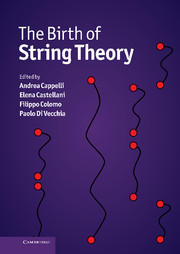Book contents
- Frontmatter
- Contents
- List of contributors
- Photographs of contributors
- Preface
- Abbreviations and acronyms
- Part I Overview
- EARLY STRING THEORY
- Part II The prehistory: the analytic S-matrix
- Part III The Dual Resonance Model
- 10 Introduction to Part III
- 11 From the S-matrix to string theory
- 12 Reminiscence on the birth of string theory
- 13 Personal recollections
- 15 Early string theory at Fermilab and Rutgers
- 15 Dual amplitudes in higher dimensions: a personal view
- 16 Personal recollections on dual models
- 17 Remembering the ‘supergroup’ collaboration
- 18 The ‘3-Reggeon vertex’
- Part IV The string
- TOWARDS MODERN STRING THEORY
- Part V Beyond the bosonic string
- Part VI The superstring
- Part VII Preparing the string renaissance
- Appendix A Theoretical tools of the Sixties
- Appendix B The Veneziano amplitude
- Appendix C From the string action to the Dual Resonance Model
- Appendix D World-sheet and target-space supersymmetry
- Appendix E The field theory limit
- Index
11 - From the S-matrix to string theory
from Part III - The Dual Resonance Model
Published online by Cambridge University Press: 05 May 2012
- Frontmatter
- Contents
- List of contributors
- Photographs of contributors
- Preface
- Abbreviations and acronyms
- Part I Overview
- EARLY STRING THEORY
- Part II The prehistory: the analytic S-matrix
- Part III The Dual Resonance Model
- 10 Introduction to Part III
- 11 From the S-matrix to string theory
- 12 Reminiscence on the birth of string theory
- 13 Personal recollections
- 15 Early string theory at Fermilab and Rutgers
- 15 Dual amplitudes in higher dimensions: a personal view
- 16 Personal recollections on dual models
- 17 Remembering the ‘supergroup’ collaboration
- 18 The ‘3-Reggeon vertex’
- Part IV The string
- TOWARDS MODERN STRING THEORY
- Part V Beyond the bosonic string
- Part VI The superstring
- Part VII Preparing the string renaissance
- Appendix A Theoretical tools of the Sixties
- Appendix B The Veneziano amplitude
- Appendix C From the string action to the Dual Resonance Model
- Appendix D World-sheet and target-space supersymmetry
- Appendix E The field theory limit
- Index
Summary
Abstract
In this Chapter I describe the ideas and developments that led to the recognition that the structure underlying the N-point scattering amplitude of the Dual Resonance Model was that of a quantum-relativistic string.
Introduction
The history of the origin of string theory is very peculiar and difficult to understand if one looks at it with today's eyes. In particular, the fact that one could understand so many string properties without making reference to any Lagrangian, and without even knowing that one was studying a string, seems almost miraculous.
In fact, the starting point for describing the property of a relativistic string is today the string Lagrangian, which is invariant under reparameterizations of the world-sheet coordinates. From it, using techniques developed for quantizing theories with local gauge invariance, such as the Faddeev–Popov and the BRST quantization, one derives the spectrum of physical states and their scattering amplitudes. However, at the end of the Sixties and at the beginning of the Seventies, these techniques were not yet known and, even though the Nambu–Goto action had already been written, it was not clear how to use it to deduce its physical consequences. Therefore, the historical path that led us to understand the properties of a relativistic string was quite different from the path that one follows today, for instance, when teaching string theory in a university course. But at that time, where did string theory come from?
- Type
- Chapter
- Information
- The Birth of String Theory , pp. 156 - 178Publisher: Cambridge University PressPrint publication year: 2012

